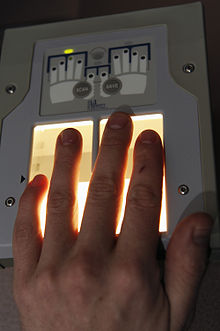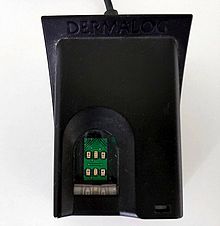Fingerprint scanner
A fingerprint scanner is a sensor for scanning a finger to generate a digital image of the fingerprint .
purpose
A fingerprint scanner can be used to take a picture of one or more fingerprints of a person. Since one of the high degree of uniqueness of the fingerprint of a person goes out, using the image of the fingerprint, a person clearly identified ( "Which person I have in front of me?") Or verified ( "If the person is actually identical to the person that they his pretending? "). Fingerprint scanners are therefore often used in combination with an automated fingerprint identification system (AFIS).
Types of fingerprint scanners
Fingerprint scanners can be classified according to different criteria:
Type of capture
Fingerprint scanners can be divided into:
- semi-automatic fingerprint scanner: With this type you have to swipe a finger over a narrow scanner surface. The quality of the generated image depends on whether or how evenly the user draws the finger over the surface and how the finger is held. They are mainly used when a very compact design is required (e.g. as an integrated device in a notebook) and / or when the price of the device plays an important role, since semi-automatic devices are often much cheaper to obtain than fully automatic ones Fingerprint scanner.
- Fully automatic fingerprint scanner: With this type, one or more fingers are placed on a surface at the same time and the scanner captures the fingerprints simultaneously and automatically. Since the quality of the fingerprint does not depend on a movement of the finger by the user, images are produced with the same or higher quality compared to semi-automatic devices.
Number of fingers that can be recorded simultaneously
Fingerprint scanners can also be divided into:
- Devices that can only detect one finger at a time,
- Devices that can capture two fingers at the same time,
- Devices that can capture more than two fingers at the same time. So-called 4 + 4 + 2 scanners are particularly common here. You capture all 10 fingers of both hands in a multi-stage process:
- Place four fingers on one hand (4),
- Place four fingers on the other hand (4),
- Place both thumbs on at the same time (2).
The user is often visually guided through the process by means of appropriate displays on the fingerprint scanner so that it is clear which fingers should be placed on when. These devices are also known as “tenprint” or “slap scanners”.
Used biometric sensor
A biometric sensor is the hardware component of a biometric system, which initially supplies the biometric measurement data - in the case of the fingerprint scanner, an image of the finger papillary lines. There are a large number of different methods that can be used to scan the papillary lines. These include:
- optical sensors
- E-field sensors
- polymer TFT sensors (TFT - Thin Film Transistor)
- thermal sensors
- capacitive sensors
- contactless 3D sensors
- Ultrasonic sensors
The most common are e.g. Z. Scanners with capacitive sensors (mainly with semi-automatic fingerprint scanners) and optical sensors with most commercially available fully automatic scanners. In some cases, however, in addition to these main sensors, additional sensors are used in higher-quality devices if, for example, life detection (with additional ultrasonic or infrared sensors) is to be implemented.
Approval by state authorities
Fingerprint scanners can also be classified according to approval by state authorities or compliance with standards.
BSI standards
In Germany, fingerprint scanners currently play a role in the official sector, especially when it comes to capturing fingerprints for official documents (primarily the “new” electronic identity card and electronic passport ). Fingerprint scanners, which are used for recording in this environment, for. B. to be used by residents' registration offices or passport offices must be carried out by the Federal Office for Information Security (BSI) in accordance with the technical guidelines "BSI TR-03104 - Technical Guideline (TR) for production data acquisition, quality check and transmission for official documents" (also called "PDÜ hD" for short) or "BSI TR-03104 Annex 2 Quality requirements for the capture and transmission of fingerprints as biometric features for electronic passports (QS fingers)" and "BSI TR-03121 - Biometrics in sovereign applications" be tested and approved.
A list of all devices currently approved for recording fingerprints for official documents can be found on the website of the Federal Office for Information Security (BSI) .
FBI standards
In the international environment, the standards PIV-071006 and IAFIS Image Quality Specifications (IQS) - Appendix F set by the FBI and the FBI Biometric Center of Excellence for the IAFIS system play an important role with regard to the quality of fingerprint scanners. Many authorities in other countries use these standards as a guide.
A list of all scanners currently approved by the FBI for capturing fingerprints in accordance with IAFIS Image Quality Specifications (IQS) can be found on the website of the FBI Biometric Center of Excellence.
Other features of fingerprint scanners
To ensure that they deliver good results for the respective application, fingerprint scanners are often supplemented with additional features that contribute to higher security or better recording results.
Life detection
Fingerprint traces, so-called latency fingerprints, are left behind regardless of the point in time as soon as smooth surfaces are touched with the fingers. An attacker could use the methods known from criminology to obtain third party prints, make copies and use them to attempt to defeat fingerprint recognition. It is therefore necessary in security-relevant applications to be able to distinguish real fingerprints from copies. For this purpose, there are various methods of life recognition in which the scanners record certain features such as pulse, blood circulation, thermal image or 3D depth patterns. These make it possible to distinguish whether the finger is being put on by a living person or whether it is a copy or dead material. For life detection u. a. optical (infrared) processes, capacitive processes and ultrasonic processes are used. A simple life detection is possible with infrared light, since dead tissue mostly absorbs this, while it is reflected by living tissue. Other methods are based on pulse oximetry and optically measure the current oxygen saturation in the bloodstream of the finger placed on it.
Integrated quality improvement algorithms
The quality of the recording of a fingerprint also largely depends on the state of the finger when it is placed on it. Among other things, different results arise with different skin types, damage, dryness or moisture of the finger. In high-quality fingerprint scanners, processes are therefore integrated that react to the condition of the finger and can optimize the image quality during the recording.
With fingerprint scanners that use optical sensors, the fingers are placed on a glass plate (or transparent surface). The soiling of the glass surface therefore also plays a role in terms of the quality of the recording produced. Some scanners therefore automatically recognize whether the contamination is still in the acceptable range or whether cleaning is necessary and may prompt you to do so (contamination detection).
See also
literature
- Maltoni, Davide: Handbook of Fingerprint Recognition . Springer, 2005, ISBN 0-387-95431-7 , (2nd edition 2009)
Web links
- Federal Office for Information Security, BSI - biometrics, fingerprint recognition
- Federal Office for Information Security, BSI - Study: "Evaluation of Biometric Systems Fingerprint Technologies - BioFinger"
- Fingerprint page by Jean-François Mainguet
- tecChannel: "Gelatine outwits fingerprint scanners"
- "How can fingerprints be reproduced?"
Individual evidence
- ↑ a b IAFIS FAQs
- ↑ Evaluation of biometric systems fingerprint technologies - BioFinger - page 11 ff.
- ↑ BSI TR-03104 Production data acquisition, quality check and transmission for official documents
- ↑ "SI TR-03104 Annex 2 Quality requirements for the recording and transmission of fingerprints as biometric features for electronic passports (QS fingers)"
- ↑ BSI TR-03121 Biometrics in sovereign applications
- ↑ Certified products - Optical fingerprint sensors
- ^ Homepage of the FBI Biometric Center of Excellence ( Memento from October 9, 2013 in the Internet Archive )
- ↑ List of all scanners approved for fingerprint capture by the FBI




